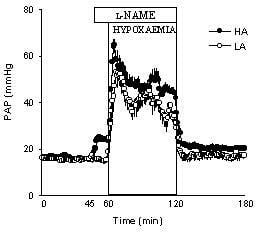NO is an important mediator in the decrease of the pulmonary vascular resistance (PVR) at birth. Since chronic hypoxia modifies the expression and activity of the endothelial nitric oxide synthase, we hypothesise that NO plays a vital role in the control of the pulmonary circulation in high altitude newborn llamas (HA), a highland adapted species. We instrumented 7 low altitude llamas (LA) (10-12 days old; 15 ± 1 kg, 580 m) and 6 HA (8-11 days old; 11 ± 1 kg, 4,600 m). Under general anaesthesia (ketamine 10 mg/kg nullI.M.null), we placed polyvinyl catheters into femoral artery and vein and a Swan Ganz catheter into the pulmonary artery. The studies commenced 3 days after surgery. All experiments were based on a 3 h protocol divided in four periods: 45 min of basal (B), 15 min of B + L-NAME (B+I), 1 h of hypoxaemia (H+I) (PO2: 33 ± 2 mmHg) and 1 h of recovery (R). The L-NAME infusion (20 mg x kg-1 bolus + 0.5 mg x kg-1 x min-1 infusion, nullI.V.null) started 15min before hypoxaemia (N+I) until the end of H+I. We performed vehicle studies in which we injected 0.9% NaCl with no significant changes due to the infusion. We measured pH, PO2, PCO2, % saturation of haemoglobin (Hb) and Hb concentration in descending aorta and pulmonary artery. Systemic arterial pressure (SAP), heart rate (HR), pulmonary arterial pressure (PAP) and cardiac output (CO, by thermodilution) were measured. Systemic vascular resistance (SVR) and PVR were calculated. Data was expressed as means + SE and analysed by two-way ANOVA and Newman-Keuls test (*p<0.05). Basally, HA had a lower PO2 (52±3* vs 95±4 mmHg), PCO2 and %sat Hb than LA. In the LA and HA, HR and CO decreased during B+I. CO remained low during H+I and R. Furthermore, an increase in SAP and SVR was observed during B+I, H+I and R in both groups. In contrast, PAP (17±2 vs 23±2* mmHg) and PVR increased in B+I only in HA. In addition both PAP and PVR increased importantly during H+I and returned to B+I values in R in both groups. The major circulatory changes observed in highland neonatal llama after L-NAME, during basal and acute hypoxaemic conditions, suggest that NO plays a vital role in the control of the pulmonary and systemic circulation in chronic hypoxaemic newborns. In contrast, in the lowland neonatal llama NO has only a role in the pulmonary circulation during hypoxaemia. Animal procedures approved by the University of Chile Ethical Committee.
King's College London (2005) J Physiol 565P, PC176
Communications: NITRIC OXIDE (NO) ROLE IN PULMONARY CIRCULATION DURING HYPOXAEMIA IN HIGHLAND AND LOWLAND NEONATAL LLAMA
Herrera, E A; Riquelme, R A; Sanhueza, E M; Ebensperger, R ; Ebensperger, G ; Reyes, V R; Giussani, D A; Blanco, C E; Hanson, M A; Llanos, A J;
1. Programa Fisiopatologia, Fac de Medicina, Universidad de Chile, Santiago, Chile. 2. Fac de Cs Quimicas y Farmaceuticas, Universidad de Chile, Santiago, Chile. 3. University of Cambridge, Cambridge, United Kingdom. 4. University of Maastricht, Maastricht, Netherlands. 5. University of Southampton, Southampton, United Kingdom. 6. INCAS, Universidad de Chile, Santiago, Chile.
View other abstracts by:
Fig 1: PAP during hypoxaemia in highland (HA) and lowland (LA) newborn llama. p<0.05: * HA vs LA; x HA vs basal; xx LA vs basal.
Where applicable, experiments conform with Society ethical requirements.

